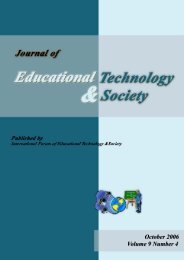Student Engagement: What do we know and what should we do?
Student Engagement: What do we know and what should we do?
Student Engagement: What do we know and what should we do?
You also want an ePaper? Increase the reach of your titles
YUMPU automatically turns print PDFs into web optimized ePapers that Google loves.
classroom to classroom. In fact, “researchers <strong>and</strong> practitioners are voicing concerns about<br />
the growing murkiness of the concept <strong>and</strong> arguing for the need to synthesize current ways<br />
of thinking about student engagement into a more coherent – <strong>and</strong> multidimensional –<br />
framework (Fredericks, 2004; Appleton, 2008; National Research Council, 2003) as cited<br />
in Dunleavy & Milton, 2009). Harris (2008) concludes her report by suggesting, “there<br />
cannot be any ‘assumed’ shared <strong>know</strong>ledge about student engagement among academics<br />
or teachers. The variation present within literature revie<strong>we</strong>d <strong>and</strong> empirical data examined<br />
shows the diverse range of meanings attached to the concept” (p. 75).<br />
Ho<strong>we</strong>ver diverse the definitions <strong>and</strong> underlying purposes of engagement, some common<br />
categories or “dimensions” are used to describe the various types of student engagement<br />
in the literature. We identify a number of these in the next section of this review.<br />
“Empirical studies over the past t<strong>we</strong>nty years have shaped the emergence of engagement<br />
as both a strategy for improving educational achievement <strong>and</strong> as an independently<br />
valuable outcome of schooling. Definitions <strong>and</strong> ways of measuring student engagement<br />
vary a lot depending on different approaches to studying the topic, but the majority of<br />
studies focus on one of two key dimensions: Social <strong>Engagement</strong> – participation in the<br />
“life” of school, <strong>and</strong> Academic <strong>Engagement</strong> – participation in the requirements of<br />
success in school” (Dunleavy & Milton, p. 7).<br />
In brief, the research literature suggested a clustering of common themes for student<br />
engagement. Definitions from various sources pointed to four or five similar categories;<br />
but, again, the text within each article often hinted at differing purposes or meanings even<br />
for the most common themes of student engagement. Harris (2008) suggests a solution:<br />
“Synchronizing the ways it is talked about <strong>and</strong> understood by educational stakeholders<br />
would increase its usefulness” (p. 75). Clarity would certainly help us make student<br />
engagement a more “useful concept for talking about student experiences <strong>and</strong> learning”<br />
(p. 75).<br />
Dissenting voices or perhaps ‘the ghosts of classrooms past’?<br />
Some critics suggest <strong>we</strong> are not enhancing learning by pursuing student engagement<br />
practices by “wooing the restless youth;” instead, <strong>we</strong> are dumbing <strong>do</strong>wn or creating a<br />
generation of spoiled, illiterate, or at least lazy writers <strong>and</strong> readers – with their “grab-<strong>and</strong>go”<br />
or “cut-<strong>and</strong>-paste” approaches to research <strong>and</strong> <strong>know</strong>ledge building. Are <strong>we</strong> in fact<br />
diluting <strong>know</strong>ledge <strong>and</strong> disposing of st<strong>and</strong>ard measures of intelligence as <strong>we</strong> allow<br />
students to explore their individual learning styles, goals <strong>and</strong> interests, as opposed to<br />
learning prescribed curriculum or teaching students <strong>what</strong> <strong>we</strong> have always taught? Some<br />
critics say “Yes!” (Carlson, 2005; Young, 2006; Carnivale, 2006; Bennett, Maton, &<br />
Kervin, 2007).<br />
Dunleavy & Milton (2009) also note that some researchers strongly suggest <strong>we</strong> need to<br />
slow <strong>do</strong>wn or stop <strong>and</strong> take a deeper, more critical look at the “assumptions underlying<br />
popular ideas about engagement” (p. 9). For example, their report suggests:<br />
<strong>Student</strong> <strong>Engagement</strong>: <strong>What</strong> <strong>do</strong> <strong>we</strong> <strong>know</strong> <strong>and</strong> <strong>what</strong> <strong>should</strong> <strong>we</strong> <strong>do</strong>? 15












